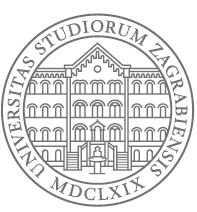Naslov Rezidualno djelovanje insekticida na parazitsku osicu Aphidius colemani Viereck, 1912 Naslov (engleski) The residual effect of insecticide on parasitic wasp Aphidius colemani Viereck, 1912 Autor Tena Krajinović Mentor Renata Bažok (mentor)Član povjerenstva Renata Bažok (predsjednik povjerenstva)Član povjerenstva Maja Čačija (član povjerenstva)Član povjerenstva Darija Lemić (član povjerenstva)Ustanova koja je dodijelila Sveučilište u Zagrebu Datum i država obrane 2021-06-18, Hrvatska Znanstveno / umjetničko BIOTEHNIČKE ZNANOSTI Sažetak Prema načelima integrirane zaštite bilja, biološkom suzbijanju štetnika uvijek se daje prednost u odnosu na kemijsko. Međutim, u nekim situacijama biološkim suzbijanjem nije moguće postići željeni učinak pa se mora kombinirati s kemijskim suzbijanjem. U tom se slučaju mogu kombinirati samo selektivni insekticid koji će „poštedjeti“ prirodnog neprijatelja i istovremeno suzbiti štetnika. U postupku registracije sredstava za zaštitu bilja potrebno je kroz istraživanja utvrditi njihov učinak na prirodne neprijatelje pri čemu se najčešće testira učinak na dvije parazitske osice, Encarsia formosa Gahan i Trichogramma cacoeciae Meyer, te na grabežljivu grinju Phytoseiulus persimilis Athias-Henriot. Cilj istraživanja bio je utvrditi ima li insekticid A19526X zasnovan na novoj djelatnoj tvari rezidualno djelovanje na mumije parazitske osice Aphidius colemani Viereck (Hymenoptera: Braconidae) i kakav je njegov utjecaj na biotički potencijal osica koje su se razvile iz tretiranih mumija. U istraživanju su bila uključena dva komercijalna insekticida (spirotetramat i imidakloprid), istraživani insekticid A19526X u tri različite doze i kontrola s vodom. Pokus se provodio u šest varijanti s pet ponavljanja. Za test izravnog kontaktnog djelovanja mumije parazitske osice tretirane su insekticidom i narednih pet dana praćen je izlazak novoizašlih osica. U testu nije utvrđeno negativno djelovanje istraživanog insekticida jer je postotak novoizašlih osica bio podjednak na svim varijantama uključujući i netretiranu kontrolu. Preživjelim osicama determiniran je spol od čega je ukupno bilo 19 ženki koje su kasnije podvrgnute rezidualnom testu toksičnosti. Na prethodno uzgojene biljke paprike inficirane pamukovom lisnom uši (Aphis gossypii Glover) koje su bile izolirane u cilindrima individualno su ispuštane ženke parazitske osice. Nakon 14 dana postotak parazitacije koji su ostvarile osice razvijene iz tretiranih mumija nije se značajno razlikovao od netretirane kontrole. S obzirom na dobivene rezultate, istraživani insekticid A19526X može se kategorizirati prema IOBC skali kao bezopasan i siguran za parazitsku osicu Aphidius colemani. Također, insekticid A19526X može se smatrati pogodnim u objektima gdje se istovremeno primjenjuju kemijske i biološke mjere zaštite od štetnika. Učinak insekticida A19526X na druge vrste prirodnih neprijatelja koji se mogu primjenjivati u staklenicima trebalo bi dodatno istražiti.
Sažetak (engleski) According to the principles of integrated plant protection, biological pest control is always given priority over chemical pest control. However, in some situations it is not possible to achieve the desired effect by biological control, so it must be combined with chemical control. In this case, only a selective insecticide can be combined that will "spare" the natural enemy and at the same time control the pest. In the process of registration of plant protection products, it is necessary to determine their effect on natural enemies through research, most often testing the effect on two parasitic wasps, Encarsia formosa Gahan and Trichogramma cacoeciae Meyer, and on the predatory mite Phytoseiulus persimilis Athias-Henriot. The aim of the study was to determine whether the insecticide A19526X based on the new active substance has a residual effect on the mummy of the parasitic wasp Aphidius colemani Viereck (Hymenoptera: Braconidae) and what is its impact on the biotic potential of wasps that developed from treated mummies. Two commercial insecticides (spirotetramate and imidacloprid), the investigated insecticide A19526X in three different doses and untreated control were included in the study. The experiment was conducted in six variants with five repetitions. For the test of direct contact action, parasitic wasps mummies were treated with insecticide and the release of newly emerged wasps was monitored for the next five days. The test did not reveal a negative effect of the investigated insecticide because the percentage of newly emerged wasps was the same in all variants, including the untreated control. The sex of the surviving wasps was determined, of which a total of 19 females were subsequently subjected to a residual toxicity test. Female parasitic wasps were individually dropped on previously grown pepper plants infected with cotton aphids (Aphis gossypii Glover) that were isolated in cylinders. After 14 days, the percentage of parasitism achieved by wasps developed from treated mummies did not differ significantly from untreated control. Based on the obtained results, the investigated insecticide A19526X can be categorized according to the IOBC scale as harmless and safe for the parasitic wasp Aphidius colemani. Also, the insecticide A19526X can be considered suitable in facilities where chemical and biological pest control measures are applied at the same time. The effect of A19526X insecticide on other types of natural enemies that can be applied in greenhouses should be further investigated.
Ključne riječi
Aphidius colemani
lisne uši
biološko suzbijanje
rezistentnost
Ključne riječi (engleski)
Aphidius colemani
aphids
biological control
resistance
Jezik hrvatski URN:NBN urn:nbn:hr:204:661908 Studijski program Naziv: Fitomedicina Vrsta resursa Tekst Način izrade datoteke Izvorno digitalna Prava pristupa Pristup svim korisnicima iz sustava znanosti i visokog obrazovanja RH Uvjeti korištenja Repozitorij Repozitorij Agronomskog fakulteta u Zagrebu Datum i vrijeme pohrane 2021-10-01 11:57:59


